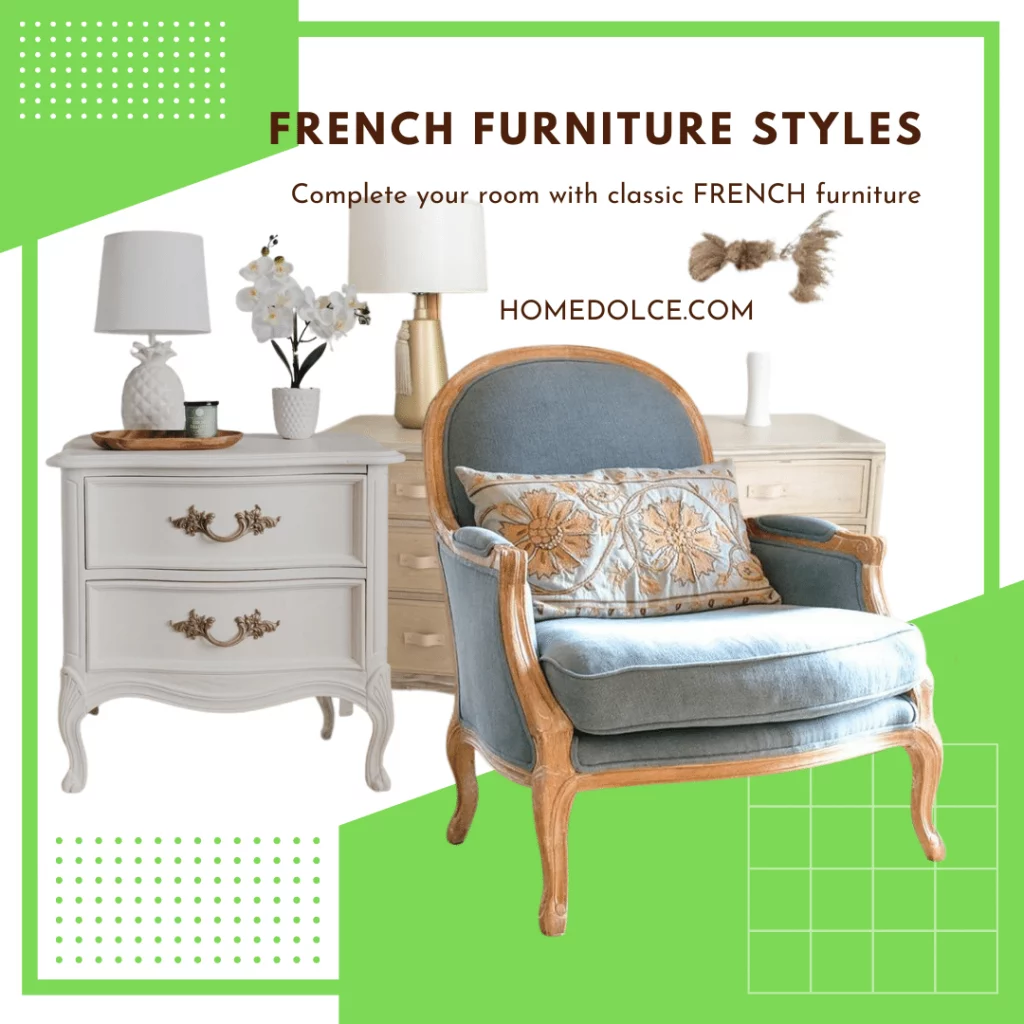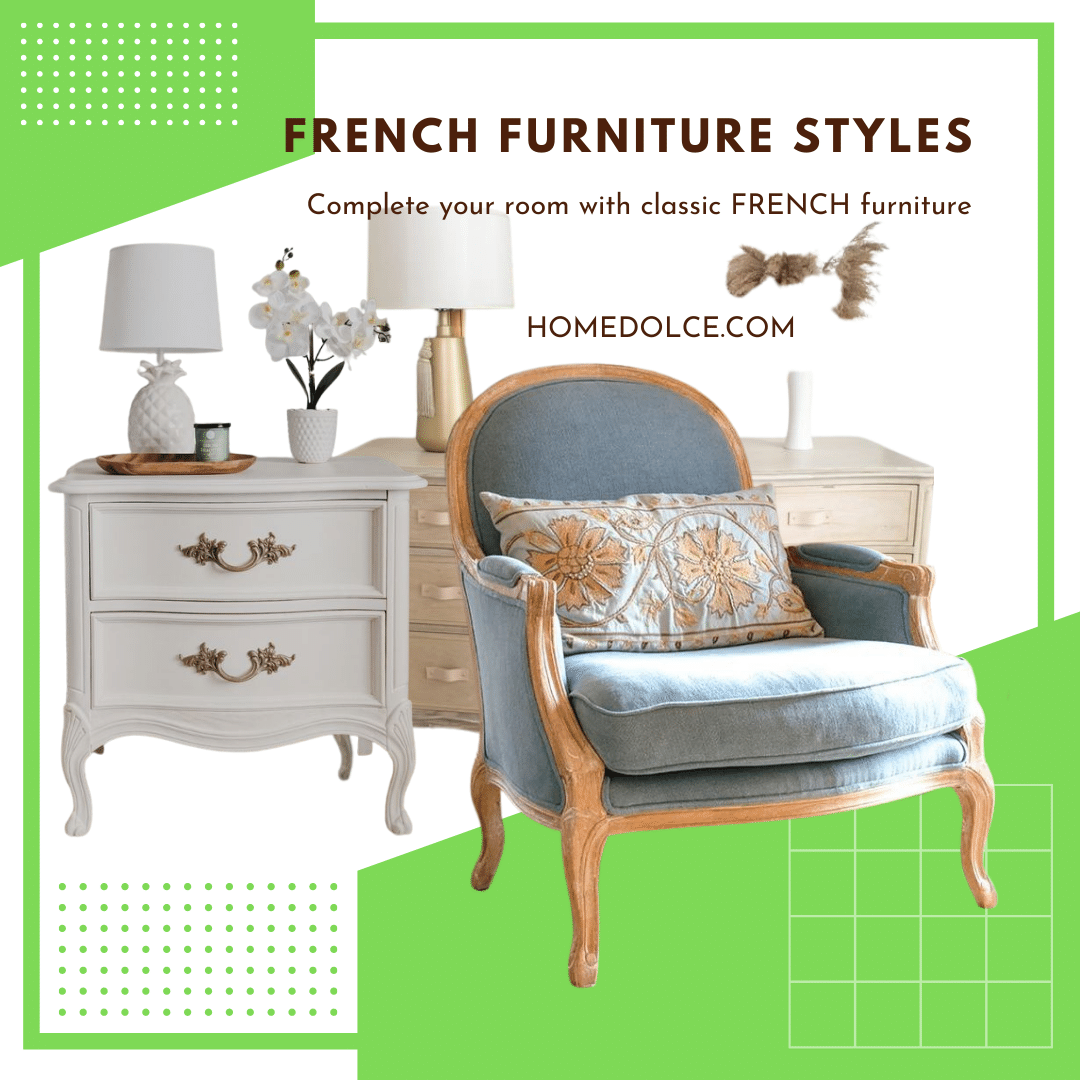
French furniture is unique, classy, and sophisticated, especially designs such as French boudoir, armoires, cabinets, dining sets, and other luxury designer accessories. These types of French furniture are known for their appeal to an individual and specific to any individual style rather than more common in this present-day’s latest styles due to its old and traditional look. If you’re looking for a perfect gift to bring comfort to you and your family or even to anyone that stays at your home, then these types of modern design furniture are worth investing in. In this article, we will discuss 15 types of French furniture styles.
1. Rococo Revival
Rococo Revival is a French furniture style that was popularized in the 19th century. It’s a revival of the original rococo style, popular in France. This type of furniture has ornate and elaborate decorations. Curves and scrolls are prominent in large and small elements of a piece. You’ll see angles on chair legs, drawer knobs, cabinet doors, and overall lines of a part.
This is a decorative style that is meant to be ornate and luxurious. If you want to create this look in your home, don’t be afraid to decorate with bold colors, large patterns, and many accessories.
2. Louis XVI
Louis XVI furniture is characterized by its curved legs and lines, often painted to create lighter and darker areas. The feet of Louis XVI furniture can be either curved or straight, but the legs of the chairs are usually straightforward rather than curved inwards. The feet at the front of Louis XVI chairs and tables are often square, while those at the back are rounded. In terms of materials, Louis XVI furniture was made from mahogany wood and painted with gold paint.
Most Louis XVI pieces were painted white or had a white base color with gold accents. The seatbacks of Louis XVI chairs have a tall rectangular shape that tapers towards the top; this shape is often called a “shield.” However, the seats have a rounded back to resemble an oval shape in some cases.
3. Boulle
This type of French furniture style can be distinguished by its lavish use of marquetry (the technique used to create decorative surface inlays). It typically includes figures made from tortoiseshell, brass, and pewter set into a contrasting background made from ebony. The figurines are often highly ornate and may depict mythology or other classic stories scenes.
The rest of the piece is made from exotic woods like rosewood or ebony; it may also have gilt-bronze mounts. Boulle furniture was considered high art during its time, which is why it’s so coveted today. You can find it in museums or in the homes of affluent collectors who admire its beauty and status as an antique.
4. Empire
Empire-style furniture is probably the easiest to spot out of all the furniture styles. The style features Egyptian motifs, ornate carvings, and rich materials; gilded bronze mounts and ebony wood. The pieces themselves are pretty heavy, with straight lines and a lack of curves. It’s easy to spot an Empire piece because of the distinct ornamentation: griffins and sphinxes, saber legs on tables, and long, thin legs on chairs.
You can easily spot an Empire-style chest of drawers or a side table in an antique shop as they’re very distinctive in design, but they’re also pretty pricey! If you’re looking for something more affordable that still has an Empire-style flare, you can get a bed frame with saber legs or a mirror with carvings that mimic the classic motifs.
5. Louis Xvi
Louis XVI furniture, also known as Louis Seize, is a style of furniture standard in France during the reign of Louis XVI. The style, which preceded the French Revolution, was influenced by Greek and Roman art and techniques from ancient Greece and Rome. The design of Louis XVI furniture is characterized by straight lines, geometric shapes, and neoclassical motifs such as curved legs on chairs and tables.
Furniture made in this style is often mahogany or rosewood and may be embellished with brass hardware. The pieces are typically painted white, gold, or blue to match the color palette of the time. Today you can find a wide variety of affordable reproductions in stores worldwide.
6. Napoleon III
This type of French furniture style was named after Napoleon III, and it became popular in France during the second half of the 19th century. Also known as the Second Empire style, its luxury and elegance characterized it. In architecture, this style is reminiscent of Louis XVI, but some distinct features include high, curved legs, bright colors, and rich materials.
The wood used for Napoleon III furniture is usually mahogany and chestnut. Some of the most common pieces of furniture in Napoleon III style are:
- Buffets
- Chairs
- Dressers
7. Directoire
Directoire furniture is characterized by straight lines, square backs, and a flat seat. However, it was also influenced by Ancient Egyptian art. These influences resulted in more rigid and severe furniture than the furniture of previous styles. Directoire furniture is highly geometric with straight vertical legs and horizontal crossbars or stretchers.
The feet are blocky and rectangular, sometimes with a slight backward curve. The top bars on chairs are often curved slightly downward to support the backrests and arms. Surfaces are generally unadorned, although they sometimes have a carved frieze along the bottom or top edges.
8. Sheraton
Sheraton furniture, named after Thomas Sheraton, is known for its classical style and Neo-classical elements. It has straight lines, tapered legs, and box-like shapes. It is seen as sleek and minimalist in the design elements it employs.
Sheraton-style furniture is one of the most popular styles in England, and it is often painted white or a pale color to help highlight the smooth lines. Sometimes a darker color was used on purpose to contrast.
9. Adam
The defining feature of Adam furniture is its curving lines, and arched doors and rounded chair backs are characteristic of this style. This curve is often accented by an overlay or dentil molding that emphasizes the line and adds a touch of sophistication.
In contrast, the legs of these pieces are often straight and tapered toward the bottom. The influence of neoclassicism can be seen in Adam furniture’s use of classical motifs like paterae, rosettes, and husk swags. These decorative elements provide a sense of grace to any piece they’re added to, whether a cabinet or table.
10. Regence
Regency furniture saw a shift towards lighter and more delicate forms, with greater attention to comfort. The lines were simple and elegant, the curves soft and feminine. The sense of movement was still present, but it was no longer as exaggerated as before. The furniture style was influenced by the Regency style in England, which was itself inspired by the classical motifs of ancient Greece and Rome.
The principal characteristic of Regence furniture is its curved shapes, like S-curves, C-scrolls, volutes, shells, and cabriole legs. It’s also distinguished by its light colors and use of exotic woods like mahogany or rosewood. Essential elements of this style are ornamentation, decoration, and marquetry. The decorative details are often made out of bronze or gilt brass.
11. Gothic Revival
This type of French furniture style was developed in the 19th century and is still seen in some furniture styles today. It is characterized by elaborate carvings of religious themes, such as angels and devils. The carvings can be highly ornate, with detailed faces on the heads of animals or people. Gothic Revival style furniture has a very dark look, usually colored black or brown.
Gothic Revival style furniture is sometimes made from wood that has been painted a dark color or stained. The table usually comes in deep reds and purples, although other colors may be used. The wood for Gothic Revival style furniture is generally carved from oak or cherry wood, although other types of wood can be used.
12. Art Deco
Art Deco is characterized by bold geometric shapes and lines, zigzags, and stepped patterns. Materials associated with Art Deco include streamlined wood, aluminum, lacquer, chrome, glass, mirrors, enamel, and shiny fabrics.
The color palette of Art Deco included grays with touches of black and red; silver platinum or gold metallic tones; bright blues; vibrant greens; sunny yellows; oranges; pinks; white and black. Art Deco furniture is often made of exotic woods like ebony or mahogany with chrome accents. Decorative elements are often abstract or stylized depictions of flowers.
13. Art Nouveau
Art Nouveau is a decorative art that began in the late 1800s. It’s characterized by curved, flowing lines and the use of natural motifs like flowers, plants, and animals. Architects mainly used Art Nouveau to create furniture designs meant to be functional while also appearing to flow naturally from their surroundings.
Many Art Nouveau designers believed that a piece of furniture should look like it grew out of the ground around it. Art Nouveau furniture may have been made from various materials, including wood, glass, and wrought iron, but all pieces featured ornate designs full of curves, arches, and plant-like forms.
14. Baroque Revival Furniture
Baroque Revival Furniture is a term associated with specific furniture that could be described as the revival of the Baroque style. Baroque Revival Furniture was made during the late 19th and early 20th centuries when many designers and artisans looked to the past for inspiration. The style of Baroque Revival Furniture most closely resembles Renaissance or Louis XIV-type furniture. Characteristics of Baroque Revival Furniture
- Richly carved surfaces
- Curves and asymmetry
- Exotic woods
- Flame finials on pieces such as chairs and couches
15. Beaux-Arts Style Furniture
Beaux-Arts style furniture is known for its richly decorated surfaces, often ornamented with carvings, gilding, marble, or bronze. This style often includes neoclassical architectural elements like columns and other architectural features.
Straight lines and rigorous symmetry characterize this style, and furniture pieces often feature carved fluting on the legs, elaborate brass mounts and handles, and high-quality wood veneers due to the luxurious materials used to produce Beaux-Arts style furniture like marble and bronze. This type of furniture is usually quite heavy. Pieces can be found in both private homes as well as public buildings.
Wrapping up
The French furniture pieces are usually produced with soft flowing lines, a combination of styles, and often left unfinished to bring this characteristic into the home entirely. It’s important to realize how the application of finishes will alter the perception of a piece so that an educated choice can be made for the best fit.
